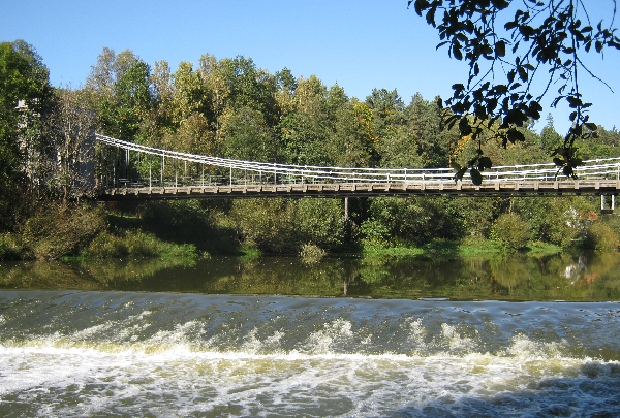
At the beginning of 2011, I wrote a blogpost entitled ‘Why I like living in Prague’. Whilst I still stand by everything I wrote twelve months ago, I should really have also added, ‘Because it also allows you to very easily explore other parts of the Czech Republic’.
Regular readers of this blog will know that Sybille & I have spent much of our holiday time these past eighteen months, exploring various different parts of this small landlocked Central European country. And whilst Prague is wonderful, there are times when some of the central parts of the city do get rather overwhelmed by tourists. But as I hope some of my previous posts have shown, there is much of beauty and historical interest elsewhere in the Czech Republic and these places see vastly fewer visitors.
The picture above is an illustration of what I mean. This is a mid-nineteenth century suspension bridge across the Lužnice River, near the village of Stádlec, about twelve kilometres west of Tábor, which we drove across in October last year. It is a beautiful spot as well as being a fascinating piece of engineering.
When originally constructed in 1847-48, the bridge took the road from Tábor to Písek across the Vltava River, near the village of Podolí. In 1960, it was dismantled, because of the flooding of that part of the valley of the Vltava River following the construction of the Orlík Dam, and replaced by a higher concrete bridge. The original bridge was then re-assembled at it current site in 1975 to replace a previous ferry crossing.
What I hope the picture also illustrates is the beauty of the Czech countryside because so much of it is forested – about 35% of the total area of the country. This is in stark contrast to the UK where the figure is no more than 10%.

Also in October 2011, I visited Brno for the first time, as part of my exploration of starting a satellite congregation in the Czech Republic’s second largest city. Although I’ve now been to Brno three times, I have still to really begin to explore all that the city has to offer. Doing so is firmly on my agenda for 2012.
In my brief walk around the city centre during my first visit to Brno, I did enjoy seeing this building, located on one side of Námestí Svobody, the main city square. In contrast to so many buildings in Prague which are supported by scantily clad female figures, here it is four extremely muscled male figures who are trying to hold up the building and hold on to their loincloths at the same time!
One area of the Czech Republic that is also on my agenda to visit during 2012 is the Orliké hory / Adlergebirge / Eagle Mountains in East Bohemia on the border with Poland. The area looks highly attractive even though it doesn’t even rate a mention in our Lonely Planet Guide to the Czech & Slovak Republics. But what has really drawn my attention is that in the heart of these mountains there is a village that bears my name – Ricky.
The village is actually called Rícky v Orlických horách, and there should be a hacek, a little hook, above both the ‘R’ and the ‘c’ in ‘Ricky, as there should be above the ‘c’ in ‘hácek’. But as I know from past experience, for technical reasons that are beyond my comprehension, if I put one in, the letter will appear as ‘?’ in the text of this blog.
‘Rícka’ means ‘stream’ and so with the ‘a’ replaced with a ‘y’, the word is made plural meaning ‘streams’. ‘v Orlických horách’ just means ‘in the Eagle Mountains’. But regardless of what it means, I’ve never previously come across anywhere called ‘Ricky’. I’m looking forward to my visit!







